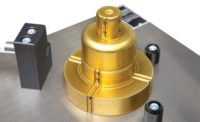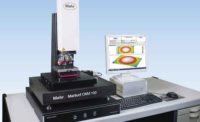Automation Makes Surface Measurement More Reliable in a Production Environment
Automation has numerous benefits for surface finish measurement.

Image Source: jkitan/E+ via Getty Images

Fully automatic measurement of surface finish and fillet radii on crankshafts.

Semi-automatic system allows the manipulation of very large parts for easy measurement .

Fully automatic measurement including multiple part fixtures and automatic probe arm changer.

7 axis enables access to any features to be measured fully automatically.





Surface finish affects how a part will fit, wear, accept coatings, and more. With the advent of new processes and materials, as well as a more advanced understanding of coating, bonding, lubrication, and friction, surfaces serve an increasingly technical function, and structure becomes an essential characteristic to ensure specified performance and longevity.
For quality purposes, these engineered surfaces must meet specific requirements known as surface finish parameters, so the ability to precisely measure finish is crucial. As surface finish measurement increasingly moves to the point of manufacture, adding automation to the process helps maximize productivity and increases quality and machining efficiency.
For surface finish measurement tools to be used in a fully automated measuring process, the equipment must be able to transmit and receive data and controls remotely—including instructions to start a measurement, change surface finish parameters for different parts, set up verification, and more. New surface finish measurement systems are designed to create more intelligent quality control operations in the production line, including advanced technologies such as integrated wireless to collect data faster and more reliably. It is also possible to build interfaces into a surface finish gage using standard I/O interfaces and protocols so they can communicate with other automated systems in the production line, such as robots and machine tools. A common way to accomplish this in the automation industry is to use a field bus interface.
Additionally, there are fully automated surface finish systems that provide a measuring sequence without operator intervention, ideal for situations when numerous features must be measured with precision and maximum flexibility is required. This type of measuring station enables the operator to move the machine around the part or the part around the machine – providing simplified access to all features needed to obtain the complete range of surface finish data required – quickly, reliably, and accurately. Meanwhile, the operator can focus on other tasks while the fully automated system measures the part independently.
Automation In Action: Surface Finish Measurement Application Examples
Electric Cars: Surface finish measurement is challenging due to very tight tolerances in electric vehicle manufacturing. For example, with no traditional engine noise to hide the sounds of the transmission/powertrain, the gear surfaces of electric vehicles must be smoother, and surface finish plays a considerable role in that. A typical handheld roughness system may not have appropriate specifications to measure it. There are also hard-to-reach areas that a handheld system cannot easily access.
We are working with several large multinational automotive manufacturers to automate the surface finish measurement of gear teeth. The manufacturers typically scan a 2D data matrix code that tells the automated surface finish measurement system “what type” of part it identifies. Then, the machine can move around the part and measure numerous gear teeth for surface finish without operator intervention.
Fuel Systems: Measuring roughness in hard-to-reach places is also challenging for many manufacturers. Narrow openings prevent the entry of many surface finish gages inside bores, tubes, cylinders, and other tight spaces. And yet, these surface finish measurements are often crucial, especially on parts where roughness affects performance.
Tight surface finish tolerance is often required for a part to perform its function. For example, surface finish provides a crucial sealant to prevent leaks in fuel injectors. A fully automated surface measurement process enables accurate and repeatable positioning to measure surface finish in even the most difficult-to-reach areas.
Semiconductor Manufacturing: Circuit boards and silicon wafers may feature a vast array of microlenses for fiber optics that include unique surface finishes that must be measured. The surface of the microlens plays a vital role in high-speed information processing, so precise measurement is critical; but the surface to be measured is tiny, with many parts. Several large semiconductor manufacturers are using automated surface finish measurement to make this possible.
Medical Implants: Products such as orthopedic implants contain a wide variety of materials with significantly different surface properties, and they must be defect-free. For example, surfaces where osseointegration is critical require extremely rough and complex features that bones can grow into and adhere to. On the other hand, a dynamic surface like a femoral head must be remarkably smooth and perfect. These parts usually need to be measured in multiple areas, and an automated surface measurement system will rotate the parts to hit them all.
Aluminum Cans: We are also working with several producers of precision grinding equipment for aluminum beverage cans, automating surface finish measurement to maximize efficiency and reduce waste. The cans start as aluminum disks and are drawn through a forming die to create the ultimate shape of the can.
The dies can only make so many thousands of cans before they must be reground and polished. Automated surface finish measurement enables manufacturers to refurbish the dies as often as necessary to maximize resources and help control costs.
Benefits Of Surface Finish Measurement Automation
Automation has numerous benefits for surface finish measurement, including:
- Making the Right Measurement: Automated surface measurement processes help ensure the right areas are being measured in hard-to-reach locations and reliable data is generated from the measurements.
- Increased Speed and Reduced Complexity: Automated surface finish measurement tools can enable an incredibly high volume of parts to be very quickly processed, regardless of shape, size, or the type of material that needs to be checked.
- Operator Productivity: Automated surface finish measurements allow an operator to make more efficient use of time without having to perform ongoing, tedious, or repetitive movements by hand.
- Error Reduction: Performing manual surface finish measurement tasks can be incredibly monotonous, increasing the chance for human error. Automating the process removes this risk.
Adding automation enables surface finish measurements to be much faster and more reliable in a production environment, enhancing the quality control process and, ultimately, the finished products.
Looking for a reprint of this article?
From high-res PDFs to custom plaques, order your copy today!










